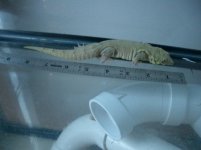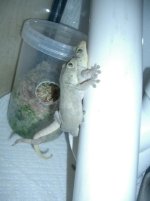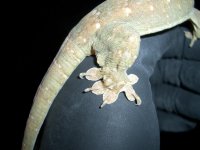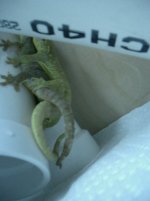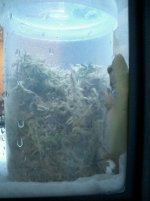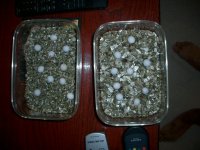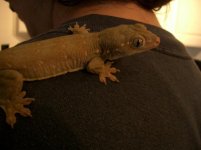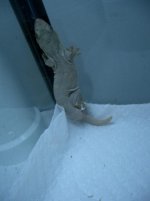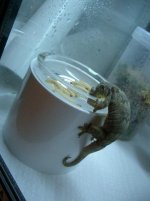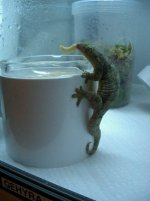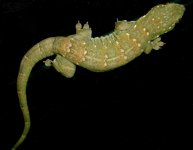You are using an out of date browser. It may not display this or other websites correctly.
You should upgrade or use an alternative browser.
You should upgrade or use an alternative browser.
Gehyra vorax
- Thread starter easytiger
- Start date
- Status
- Not open for further replies.
easytiger
New member
That would be very much appreciated Sascha! All the pics of Marginata and Oceanica I have seen look very different from these guys, unless it is a different locale, morphotype, etc...
The most info I have been able to gather on any of these species have been from outdated articles from various zoological publications via JSTOR, and even then it seems G. vorax is just an umbrella term used for a cluster of house geckos found in the Fiji/Vanuatu. Any tips would be greatly appreciated!
The most info I have been able to gather on any of these species have been from outdated articles from various zoological publications via JSTOR, and even then it seems G. vorax is just an umbrella term used for a cluster of house geckos found in the Fiji/Vanuatu. Any tips would be greatly appreciated!
PassPort
New member
It has brown eyes, which I am pretty sure is indicative of G. vorax.
It's in captivity, which I'm pretty sure is indicative of it not being vorax.
True vorax are larger than marginata and typically have colors of orange/red in them from what I've been told. They are found only on Fiji and Vanuatu to the best of my knowledge. Fiji doesn't allow the export of it's wild life and to the best of my knowledge Vanuatu does, but no one ever seems to actually be able to bring in a shipment. I'm not sure why the trade name vorax ever was used, I guess it just sounded cooler.
Good luck with properly identifying these guys.
To be honest: This surely is a very effective setup for producing these geckos, but I really do not like it from a herp keepers - and a herps- perspective.
The Gehyra species we are talking about in this thread are large and active geckos, which move a lot during the night. A spaceous setup of 65 g and more to me thus is a reasonable minimum for a pair. I would very much stay away from anything smaller, at least if the geckos therein should be kept for a longer period of time.
Of course you can provide shelter by plastic tubings and the like and provide apt climatic conditions also in a semisterile environment like yours. But nothing comes close to a naturalistic setup with respect to richness and diversity of external stimuli. In my opinion, environmental enrichment does in fact matter for herps, even though signs of hospitalism and related behavioural disorders are very subtle in such lower vertebrates.
Still, I am convinced, there IS something like "relevant quality of life" applying even to geckos.
Also, one, if not THE aim of all of us herpers is (at least I hope to speak for the majority of us) , to provide our animals with the most species-appropriate housing we can provide.
Thats, why I do not like such setups and always prefer naturalistic, but above all spaceous and richly structured tanks for herp keeping in general.
This may be compromised, if the aim is to provide the market with enough captive bred specimes to reduce the need for imports or if producing as much offspring as possible is important for other reasons (making money to me does not qualify). But in general, quality of life for our herps should matter more than maximum breeding efficiency.
After having said this, I also have to stress that breeding success in naturalistic setups is NOT compromised. It may just be less easy to find alle eggs and babies and of course, the demand on space limits the number of breeding setups in comarison to the rack like approach.
Just my 2 cts.
best
Ingo
P.S.: I myself do only keep one breeding pair of Gehyra marginata. They since 7 years share a richly structured naturalistic setup of 100 x80 x 175 cm with a pair of Phelsuma grandis and make intensive use of all that space.
The Gehyra species we are talking about in this thread are large and active geckos, which move a lot during the night. A spaceous setup of 65 g and more to me thus is a reasonable minimum for a pair. I would very much stay away from anything smaller, at least if the geckos therein should be kept for a longer period of time.
Of course you can provide shelter by plastic tubings and the like and provide apt climatic conditions also in a semisterile environment like yours. But nothing comes close to a naturalistic setup with respect to richness and diversity of external stimuli. In my opinion, environmental enrichment does in fact matter for herps, even though signs of hospitalism and related behavioural disorders are very subtle in such lower vertebrates.
Still, I am convinced, there IS something like "relevant quality of life" applying even to geckos.
Also, one, if not THE aim of all of us herpers is (at least I hope to speak for the majority of us) , to provide our animals with the most species-appropriate housing we can provide.
Thats, why I do not like such setups and always prefer naturalistic, but above all spaceous and richly structured tanks for herp keeping in general.
This may be compromised, if the aim is to provide the market with enough captive bred specimes to reduce the need for imports or if producing as much offspring as possible is important for other reasons (making money to me does not qualify). But in general, quality of life for our herps should matter more than maximum breeding efficiency.
After having said this, I also have to stress that breeding success in naturalistic setups is NOT compromised. It may just be less easy to find alle eggs and babies and of course, the demand on space limits the number of breeding setups in comarison to the rack like approach.
Just my 2 cts.
best
Ingo
P.S.: I myself do only keep one breeding pair of Gehyra marginata. They since 7 years share a richly structured naturalistic setup of 100 x80 x 175 cm with a pair of Phelsuma grandis and make intensive use of all that space.
Last edited:
Green-eyed Gecko
New member
I think this set up is ok and for me there is no reason to criticize it! I mean I usually prefer more naturalistic tanks with more space but those gehyra's look pretty healthy! Besides that it's nice to see people who care about this genus and take care to breed them !
!
HEY INDIGO
HOW CAN I SAY THIS IN A NICE WAY?
THERE IS NO NICE WAY!
I DON'T CARE HOW YOU KEEP YOUR ANIMALS!
I HAD REPTILES SINCE THE AGE OF 9
I BEEN BREEDING GECKO'S SINCE THE AGE OF 17
I'M NOW 41
PREACH TO SOMEON ELSE!
I KNOW WHAT WORKS AND WHAT DOES NOT WORK FOR ME.
HOW LONG HAVE YOU BEEN BREEDING GEHYRA OCEANICA?
HOW MANY HAVE YOU PRODUCED?
MY NUMBERS SPEAK VOLUMES COMPARED TO OTHERS WHO HAVE BEEN BREEDING THEM
I HAVE KEPT THEM IN A NATURALISTIC SET UP BEFORE.
GUESS WHAT?
THE SET UP YOU SEE WORK'S 100 TIMES BETTER!
MORE SANITARY WITH OUT THE STENCH BUILDING UP ON THE COARK BARK
AND EASY TO CLEAN UP
YOU KNOW HOW MANY PEOPLE WHO HAVE SEEN MY SET UP CHANGED TO THE WAY I SET THEM UP
37 PEOPLE JUST IN THE 3 MONTHS I WAS ON KINGSNAKE.COM SELLING & TRADING
AND MARGINATA ARE MUCH BIGGER THAN OCEANICA SO OF COURSE YOU SHOULD PUT THEM IN A BIGGER ENCLOSURE
THIS ENCLOSURE WORKS FINE FOR THEIR SIZE I NEVER HAD A PROBLEM
SO BEFORE YOU START RANTING OR CRITICIZING ABOUT SOMEONES SET UP
YOU SHOULD WEIGH THE PRO'S AND CON'S
I'M HERE TO SHOW A DIFFERENT WAY IF YOU DONT LIKE IT,
I DON'T CARE WHAT YOU LIKE
I'M JUST TRYING TO SHOW EVERYONE ANOTHER WAY THAT ACTUALLY WORKS FOR THIS SPECIES
AND AGAIN I DON'T CARE WHAT YOU LIKE
YOU WANT THE STENCH AND MOLD BUILDING UP IN YOUR CAGES
BY ALL MEANS YOU CAN KEEP THE STENCH AND MOLD
AND KEEP SPENDING MONEY ON COARK BARK
YOU DO YOUR SET UP YOUR WAY
I DO MINE, MY WAY!
SO FOR ALL THOSE READING THIS THREAD IF I SOUND ABRASIVE
IT'S BECAUSE IM AM
I DONT NEED ANYONE TELLING ME OR ATTACKING ME ON THIS FORUM
WHERE,..
YOUR SUPPOSED TO SHARE INFORMATION ON KEEPING AND BREEDING GECKO'S
NOT COOL THE WAY YOU CAME OUT INDIGO
YOU SOUND VERY ARROGANT & PRETENTIOUS IN YOUR REPLY ,ilm
THIS IS ANOTHER REASON WHY I ONLY TROLLED THIS FORUM
TOO MANY PEOPLE RUNNING THEIR MOUTHS, WITH OUT THE FACTS!
OR,... WITH OUT ASKING QUESTIONS FIRST BEFORE THEY SPEAK
SO IF I GET KICKED OFF THIS FORUM BECAUSE OF MY REPLY THEN SO BE IT
TOO MANY KNOW IT ALLS THAT DON'T KNOW HOW TO HAVE A LITTLE BIT OF DECORUM OR ETIQUETTE SO TO SPEAK
AND THANK YOU GREEN-EYED-GECKO FOR SAYING SOMETHING
I WISH I WOULD HAVE SEEN HIS REPLY MUCH EARLIER
BEST TO YOU
LATER PEOPLE :biggrin:
HOW CAN I SAY THIS IN A NICE WAY?
THERE IS NO NICE WAY!
I DON'T CARE HOW YOU KEEP YOUR ANIMALS!
I HAD REPTILES SINCE THE AGE OF 9
I BEEN BREEDING GECKO'S SINCE THE AGE OF 17
I'M NOW 41
PREACH TO SOMEON ELSE!
I KNOW WHAT WORKS AND WHAT DOES NOT WORK FOR ME.
HOW LONG HAVE YOU BEEN BREEDING GEHYRA OCEANICA?
HOW MANY HAVE YOU PRODUCED?
MY NUMBERS SPEAK VOLUMES COMPARED TO OTHERS WHO HAVE BEEN BREEDING THEM
I HAVE KEPT THEM IN A NATURALISTIC SET UP BEFORE.
GUESS WHAT?
THE SET UP YOU SEE WORK'S 100 TIMES BETTER!
MORE SANITARY WITH OUT THE STENCH BUILDING UP ON THE COARK BARK
AND EASY TO CLEAN UP
YOU KNOW HOW MANY PEOPLE WHO HAVE SEEN MY SET UP CHANGED TO THE WAY I SET THEM UP
37 PEOPLE JUST IN THE 3 MONTHS I WAS ON KINGSNAKE.COM SELLING & TRADING
AND MARGINATA ARE MUCH BIGGER THAN OCEANICA SO OF COURSE YOU SHOULD PUT THEM IN A BIGGER ENCLOSURE
THIS ENCLOSURE WORKS FINE FOR THEIR SIZE I NEVER HAD A PROBLEM
SO BEFORE YOU START RANTING OR CRITICIZING ABOUT SOMEONES SET UP
YOU SHOULD WEIGH THE PRO'S AND CON'S
I'M HERE TO SHOW A DIFFERENT WAY IF YOU DONT LIKE IT,
I DON'T CARE WHAT YOU LIKE
I'M JUST TRYING TO SHOW EVERYONE ANOTHER WAY THAT ACTUALLY WORKS FOR THIS SPECIES
AND AGAIN I DON'T CARE WHAT YOU LIKE
YOU WANT THE STENCH AND MOLD BUILDING UP IN YOUR CAGES
BY ALL MEANS YOU CAN KEEP THE STENCH AND MOLD
AND KEEP SPENDING MONEY ON COARK BARK
YOU DO YOUR SET UP YOUR WAY
I DO MINE, MY WAY!
SO FOR ALL THOSE READING THIS THREAD IF I SOUND ABRASIVE
IT'S BECAUSE IM AM
I DONT NEED ANYONE TELLING ME OR ATTACKING ME ON THIS FORUM
WHERE,..
YOUR SUPPOSED TO SHARE INFORMATION ON KEEPING AND BREEDING GECKO'S
NOT COOL THE WAY YOU CAME OUT INDIGO
YOU SOUND VERY ARROGANT & PRETENTIOUS IN YOUR REPLY ,ilm
THIS IS ANOTHER REASON WHY I ONLY TROLLED THIS FORUM
TOO MANY PEOPLE RUNNING THEIR MOUTHS, WITH OUT THE FACTS!
OR,... WITH OUT ASKING QUESTIONS FIRST BEFORE THEY SPEAK
SO IF I GET KICKED OFF THIS FORUM BECAUSE OF MY REPLY THEN SO BE IT
TOO MANY KNOW IT ALLS THAT DON'T KNOW HOW TO HAVE A LITTLE BIT OF DECORUM OR ETIQUETTE SO TO SPEAK
AND THANK YOU GREEN-EYED-GECKO FOR SAYING SOMETHING
I WISH I WOULD HAVE SEEN HIS REPLY MUCH EARLIER
BEST TO YOU
LATER PEOPLE :biggrin:
Green-eyed Gecko
New member
Hey Gehyra,
it's a desire for me to add that I agree with you in all points!
P.s. It's funny to here someone talking about naturalistic set up's who is keeping Gehyra marginata and Phelsuma grandis together in one tank!:lol:
it's a desire for me to add that I agree with you in all points!
P.s. It's funny to here someone talking about naturalistic set up's who is keeping Gehyra marginata and Phelsuma grandis together in one tank!:lol:
OK, keep on shouting.
However, since you stressed your experiences so much, I may do that as well:
I am 45 now, I do keep herps since 40+ years and I bred my first gecko species 34 years ago.
I do hold a Dr in biology, I spent a lot of my time in university on herpetological topics and I do still read lots of herpetological papers. I also did write quite some papers and books on herpetoculture, which by the way all were well percieved by the community.
Currently I am working on a book on husbandry of geckos from the genus Gekko and on a book on technology in herpetoculture.
So I may be right to say, I am not a noob.
You may recall that I said your way of housing can be effective when it comes to breeding and I did by no means say that it is an absolutely unacceptable way of herping. It can provide large numbers of offspring with little effort and sometimes this can be a very goog and meaningful argument. It also well fits the needs and wishes of many herpers, which to me is a less strong argument if it does less well fit the needs of the respective herps, which I in fact think is the case here.
Also, I think, I tried to pack my criticism in comparably nice words. Maybe I was not too good in that, but then blame it on the fact, that english is not my first language and accept my apologies.
However, you as a native speaker obviously can not do that better than I and after all, I do still stick to the content of my criticism.
From a psycholocical point of view btw, I do find the way you react quite interesting. Very emotional, shouting style and agressive. More adolescent like, than like an adult. Maybe because you know, that there may be ways of herping, which do better fit the needs of your animals????
At least, one may immediately think about that.
Of course, your type of setup is very easy and efficient when it comes to maintenance and collection of eggs. Thus, I do fully understand that such setups can be attractive to herpers.
However, in relation to the size of your geckos, the size of the enclosure is undebatebly small and also the structure of the tanks does not fulfill more than the bare minimum needs of the animals.
These setups are extremely poor in environmental stimuli. Moreover, they are too small to provide the gradients of abiotic parameters which ectotherms need to actively regulate their metabolism.
At least the latter is not a matter of debate, its a fact. You can funtionally replace spatial by temporal gradients to quite some extent of course. But that still withdraws any opportunity of active regulation from the animals itself and puts a high demand on the keeper in doing these things right.
It is true, that artificial habitats can be much smaller than their natural counterparts if they provide all necessary structures in that space-but to the best of my knowlegde and experience what I do see on these pics is way too small.
Your Pics show semisterile setups, useful for breedng and providing the minimum needs of the geckos kept within. No doubt. The pics also clearly show the size of the enclosures in relation to the size of the geckos kept there. And sorry, that keeps saying me I do not like it, since it restricts movements of the inhabitants to an unecessary and not easily acceptable extent.
Restricting an actively moving vertrebrate to a cube with side lengths less than 3 fold its length in my opinion still is far from being optimum and despite of being an option, I do clearly not consider it recommendable. Period. When I do talk about naturalisitic setups, I of course do not necessarily mean exact copies of a natural habitat. This would not even be a good choice, since in the restricted space of a captive setup, structuration has to be provided significantly denser than in nature.
Also, the animals do not care about geographial origin of cage material, plants or cagemates. They do care about the resulting setup with respect to gradients of abiotic and biotic parameters and about structures providing shelter, activity areas, thermoregulation opportunities and and and.
I also stick to my statement that environmental enrichment does matter for herps and its nothing less than a matter of fact that such semisterile setups are poor in providing external stimuli.
I also stick to the fact that to my sincere opinion the only reason, why so many herpers do insist that comparably small enclosures are not just sufficient but a good choice is, that providing small enclosures allows for more of that within the same floor space.
I DO NOT SECOND THAT -see, I can shout as well :biggrin:
You stumble upon the fact that I do keep G. marginata together with P.grandis?
Well, I admit thats provocative. However, there is quite some evidence that non conspecific cagemates in many vertebrates can not only be seen as a part of environmental enrichment but can also reduce intraspecific aggression. They do that by just providing lots of external stimuli and that the dependent loss of intraspecific agression does not necessarily result in an increase in interspecific agression.
In the given case, the presence of the Gehyra remarkably reduce male female aggression in grandis in my hands. This statment is based on intense observtions over many years and under different conditions.
Both species of course do not care about the georgraphic origin of potential cagemates. The only thing of importance is that cagemates are not seen as competitors for territory, as prey or as a threat. Neither is the case with this combination. Of course, a well structured generoulsly sized enclosure is prerequisite for such a two species setup. But then, I am absolutely convinced that the presence of such cagemates can be beneficial with respect to enrichment parameters.
In fact, sometimes non conspecific cagemates can be a better choice than conspecific ones. For several solitary herp species, I do keep single animals together with single animals of another species but seperate from the respective other sex, which I only introduce for mating. I do have excellent experiences with this approach.
You have been aslking about my Gehyra pair specifically: These do live together since seven years. Clutches I have to collect from either the inner parts of big bamboos sticks or the leaflitter. The female lays two eggs every 6-8 weeks. I never had one not hatch. A slightly dryer and cooler period in winter leads to a wanted pause in egg production from October to March. Very much the same applies for the grandis. The male in that tank hatched in an ancestor of that tank in 1989 and since two years, fertilization rate of eggs sired by him drops.
I also want to give a comment on sanitary aspects: As a trained microbiologist, I can tell you that these semisterile setups are not necessaryly more hygienic. Lots of bacteria still grow and thrive on seemingly clean surfaces, including potential pathogens from the feces of diseased animals. In a healthy naturalistic setup, inoculated with arthripod soil fauna, a stable microbiotic flora develops. This can buffer and overgrow potential pathogens and does not allow gut bacteria from the feces to grow excessively. From a microbiologicalperspective, a naturalistic setuo is much more stable than a semisterile one and the risk of explosive growth of oppoertunisticallypathogenic bacteria is in fact lower.
Best
Ingo
@ green eyed gecko: You disappoint me alot.
This is the tank,I am talking about in this case. It does not emit any stench, never. It smells like deciduous forest soil.

However, since you stressed your experiences so much, I may do that as well:
I am 45 now, I do keep herps since 40+ years and I bred my first gecko species 34 years ago.
I do hold a Dr in biology, I spent a lot of my time in university on herpetological topics and I do still read lots of herpetological papers. I also did write quite some papers and books on herpetoculture, which by the way all were well percieved by the community.
Currently I am working on a book on husbandry of geckos from the genus Gekko and on a book on technology in herpetoculture.
So I may be right to say, I am not a noob.
You may recall that I said your way of housing can be effective when it comes to breeding and I did by no means say that it is an absolutely unacceptable way of herping. It can provide large numbers of offspring with little effort and sometimes this can be a very goog and meaningful argument. It also well fits the needs and wishes of many herpers, which to me is a less strong argument if it does less well fit the needs of the respective herps, which I in fact think is the case here.
Also, I think, I tried to pack my criticism in comparably nice words. Maybe I was not too good in that, but then blame it on the fact, that english is not my first language and accept my apologies.
However, you as a native speaker obviously can not do that better than I and after all, I do still stick to the content of my criticism.
From a psycholocical point of view btw, I do find the way you react quite interesting. Very emotional, shouting style and agressive. More adolescent like, than like an adult. Maybe because you know, that there may be ways of herping, which do better fit the needs of your animals????
At least, one may immediately think about that.
Of course, your type of setup is very easy and efficient when it comes to maintenance and collection of eggs. Thus, I do fully understand that such setups can be attractive to herpers.
However, in relation to the size of your geckos, the size of the enclosure is undebatebly small and also the structure of the tanks does not fulfill more than the bare minimum needs of the animals.
These setups are extremely poor in environmental stimuli. Moreover, they are too small to provide the gradients of abiotic parameters which ectotherms need to actively regulate their metabolism.
At least the latter is not a matter of debate, its a fact. You can funtionally replace spatial by temporal gradients to quite some extent of course. But that still withdraws any opportunity of active regulation from the animals itself and puts a high demand on the keeper in doing these things right.
It is true, that artificial habitats can be much smaller than their natural counterparts if they provide all necessary structures in that space-but to the best of my knowlegde and experience what I do see on these pics is way too small.
Your Pics show semisterile setups, useful for breedng and providing the minimum needs of the geckos kept within. No doubt. The pics also clearly show the size of the enclosures in relation to the size of the geckos kept there. And sorry, that keeps saying me I do not like it, since it restricts movements of the inhabitants to an unecessary and not easily acceptable extent.
Restricting an actively moving vertrebrate to a cube with side lengths less than 3 fold its length in my opinion still is far from being optimum and despite of being an option, I do clearly not consider it recommendable. Period. When I do talk about naturalisitic setups, I of course do not necessarily mean exact copies of a natural habitat. This would not even be a good choice, since in the restricted space of a captive setup, structuration has to be provided significantly denser than in nature.
Also, the animals do not care about geographial origin of cage material, plants or cagemates. They do care about the resulting setup with respect to gradients of abiotic and biotic parameters and about structures providing shelter, activity areas, thermoregulation opportunities and and and.
I also stick to my statement that environmental enrichment does matter for herps and its nothing less than a matter of fact that such semisterile setups are poor in providing external stimuli.
I also stick to the fact that to my sincere opinion the only reason, why so many herpers do insist that comparably small enclosures are not just sufficient but a good choice is, that providing small enclosures allows for more of that within the same floor space.
I DO NOT SECOND THAT -see, I can shout as well :biggrin:
You stumble upon the fact that I do keep G. marginata together with P.grandis?
Well, I admit thats provocative. However, there is quite some evidence that non conspecific cagemates in many vertebrates can not only be seen as a part of environmental enrichment but can also reduce intraspecific aggression. They do that by just providing lots of external stimuli and that the dependent loss of intraspecific agression does not necessarily result in an increase in interspecific agression.
In the given case, the presence of the Gehyra remarkably reduce male female aggression in grandis in my hands. This statment is based on intense observtions over many years and under different conditions.
Both species of course do not care about the georgraphic origin of potential cagemates. The only thing of importance is that cagemates are not seen as competitors for territory, as prey or as a threat. Neither is the case with this combination. Of course, a well structured generoulsly sized enclosure is prerequisite for such a two species setup. But then, I am absolutely convinced that the presence of such cagemates can be beneficial with respect to enrichment parameters.
In fact, sometimes non conspecific cagemates can be a better choice than conspecific ones. For several solitary herp species, I do keep single animals together with single animals of another species but seperate from the respective other sex, which I only introduce for mating. I do have excellent experiences with this approach.
You have been aslking about my Gehyra pair specifically: These do live together since seven years. Clutches I have to collect from either the inner parts of big bamboos sticks or the leaflitter. The female lays two eggs every 6-8 weeks. I never had one not hatch. A slightly dryer and cooler period in winter leads to a wanted pause in egg production from October to March. Very much the same applies for the grandis. The male in that tank hatched in an ancestor of that tank in 1989 and since two years, fertilization rate of eggs sired by him drops.
I also want to give a comment on sanitary aspects: As a trained microbiologist, I can tell you that these semisterile setups are not necessaryly more hygienic. Lots of bacteria still grow and thrive on seemingly clean surfaces, including potential pathogens from the feces of diseased animals. In a healthy naturalistic setup, inoculated with arthripod soil fauna, a stable microbiotic flora develops. This can buffer and overgrow potential pathogens and does not allow gut bacteria from the feces to grow excessively. From a microbiologicalperspective, a naturalistic setuo is much more stable than a semisterile one and the risk of explosive growth of oppoertunisticallypathogenic bacteria is in fact lower.
Best
Ingo
@ green eyed gecko: You disappoint me alot.
This is the tank,I am talking about in this case. It does not emit any stench, never. It smells like deciduous forest soil.

Last edited:
- Status
- Not open for further replies.




